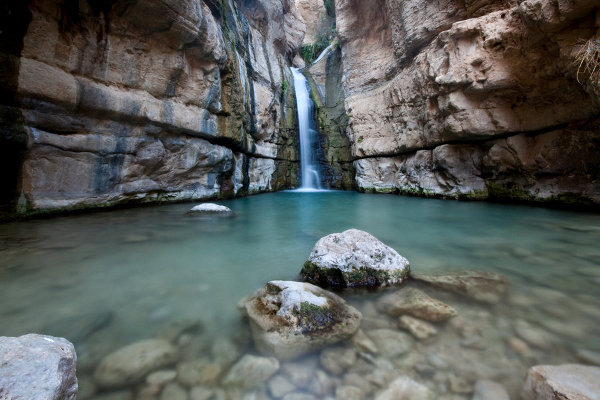Ein Gedi National Park
December 23rd 2014

Thanks to rainfall in the Judean Mountains, Ein Gedi National Park is a wellspring amidst the surrounding desert. First-time visitors are often taken aback by the juxtaposition – while the surrounding desert is dry and brown, Ein Gedi is alive, bursting with wildlife, rich vegetation and cool, clear streams and waterfalls. It is a vibrant oasis—a nature reserve with fun, family-friendly trails and clean pools of water.
The lower Nachal David (David’s Stream) trail is the way to go for most hikers. Walking this trail to the main waterfall is a highlight of every visit to Ein Gedi National Park. Splash around and cool off in the waterfall along with other hikers. Along the way, note many of the kinds of trees that dot the entire nature reserve, including acacia trees and Egyptian balsams. Keep your eyes out for herds of ibex and groups of hyrax, which you’ll likely experience up-close and personally. The reserve is also home to foxes, wolves, hyenas and spotted leopards, although these rarer animals tend to come out in the evenings.
Nachal David is named for King David, who hid here when he was being pursued by King Saul, as described in the Bible’s Book of Samuel. This circular walk takes about an hour and will fill you with appreciation for the wonders of nature – misleadingly close to Jerusalem in distance, but a million miles away in atmosphere.
The Upper David Trail which begins at Nachal David and continues up to Shulamit Spring and the top of the David waterfall is recommended only for experienced hikers. Along the shores of Nachal David is also the site where an ancient temple from the Chalcolithic period (5,000 years ago) was discovered. Visitors can still see some of the temple’s mysterious mosaic inscriptions. And to the south is Nachal Arugot, a second canyon with its own series of waterfalls that many find to be even more beautiful.
Other, more challenging trails that are available for intermediate and experienced hikers include the Tsafit trail to the Ein Gedi Spring, the hike from the Field School to Mount Yishai, the hike from Tel Goren to the Ein Gedi Spring and the hike from Kibbutz Ein Gedi to desert plateau via the Tsruya Ascent. These more advanced hikes, some of which are all-day affairs, should only be undertaken with the advice of the park rangers and your tour guide.
Ein Gedi National Park is partially wheelchair accessible.











